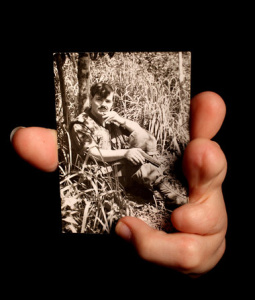By Connie Schultz, with photographs by Nick Ut
Vietnam and the United States have a common enemy. Its name is Agent Orange. From 1962 to 1971, the U.S. military sprayed millions of gallons of the herbicide, which contained the toxic chemical dioxin, to defoliate the jungles and forests that gave cover to Ho Chi Minh’s northern forces in what was then South Vietnam.
At least 4.5 million Vietnamese, and the 2.5 million Americans who served there, may have been exposed to Agent Orange. These numbers do not reflect the possible impact on future generations.
The U.S. Veterans Administration now recognizes 15 illnesses linked to war-time exposure. The Vietnam Red Cross estimates that roughly 3 million adults and children continue to suffer illnesses and birth deformities because of these contaminated sites. This is a fixable problem. To the majority of Americans, it is also an invisible one.
Photo Essays:
Friendship Village, by Nick Ut
Mushroom Farm, by Nick Ut
Part 1: The Vietnam War ended but a silent threat from Agent Orange remained

Fear of deformities from exposure to Agent Orange drives expectant mothers to storefront clinics like this one in downtown Hanoi, where many undergo multiple ultrasounds without doctors' referrals. Nick Ut, VRP
Today, more than 2 million acres in Vietnam remain barren. Numerous studies have shown that “hot spots” on the perimeter of former U.S. bases in the south still leach dioxin into the soil, contaminating water, vegetation, wildlife — and people. Field researchers have found dioxin in nursing mothers’ milk and bloodstream, at far greater than established safe levels.
Part 2: Friendship Village provides support to people affected by Agent Orange

Le Duc Quang, 20, has lived for four years in Friendship Village, which was founded by American Vietnam War veteran George Mizo to give medical care to children with disabilities caused by exposure to Agent Orange and help some of them learn marketable skills. Nick Ut, VRP
More than 100 children, from age 6 to 20 or so, live at Friendship Village for two to four years for medical treatment, rehabilitation and job training. At any given time, 40 or so war veterans who were exposed to Agent Orange also stay at the Village for a few months’ respite care.
Part 3: Agent Orange leads Heather Bowser to connect with her father’s past in Vietnam
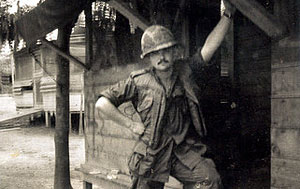
Bill Morris left for Vietnam in 1968, full of American patriotism and a sense of duty. He never stopped loving his country, but he never forgave the U.S. government for his exposure to Agent Orange, and what he was certain it did to his only daughter. Courtesy of Heather Bowser
As the plane descended toward Hanoi’s Noi Bai International Airport, her anxiety soared. The 38-year-old Ohio native had been planning this trip for a long time, but now that she was nearly there, uncertainty was beginning to mute the buzz of her initial excitement.
Part 4: Agent Orange leaves its mark on the life of Heather Bowser

Heather Bowser describes herself as a child of Agent Orange. Bowser, who was born without several fingers and is missing part of her right leg, is convinced the cause was Agent Orange. Her father, Bill Morris, fought in Vietnam and was exposed to Agent Orange. Lisa DeJong, PD
Heather was 9 months old when she was fitted for her first prosthesis, which belted around her waist and didn’t bend at the knee. She was a quick study, in part because her parents were relentless teachers in the art of can-do.
Part 5: Bowser, children touched by AO find common bond in Friendship Village
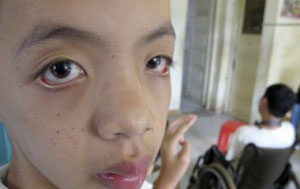
Hoang Trung Kien, 23, is one of thousands of children identified as third-generation victims of Agent Orange. He currently lives in Friendship Village outside Hanoi, far from loved ones as he learns a skill and receives crucial medical care. Nick Ut, VRP
Heather’s heart sank when she entered the gates of Friendship Village. She was shocked to see the isolated, rural setting of Friendship Village, which was partially built on former rice fields. She was taken aback by the neglected grounds. Heather’s mood changed when she met the children.
Part 6: Ending the lingering threat of Agent Orange begins with awareness

Heather Bowser found a 12-year-old boy whose limb loss matched hers almost exactly. "Tell me I'm not a victim of Agent Orange," she says. Courtesy of Heather Bowser
Heather Bowser continues to wrestle with what she discovered about herself in Vietnam. She holds tight to the many wonderful memories of her trip, but she also admits to moments of despair that she can’t quite explain. Not yet, anyway.
EXTRAS
Mushroom Farm gives women veterans exposed to AO a place, a purpose, a life
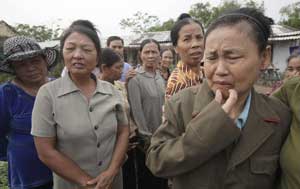
Vietnam's women veterans had no community that wanted them, or their children and grandchildren with disabilities, until they created one for themselves on a mushroom farm and commune in Ninh Binh Province. "The poor take care of the poorer," one veteran said. Photo by Nick Ut, VRP.
In 1996, war veteran Madame Cuc founded the mushroom farm co-op, where the women now work together to grow and harvest various types of edible and medicinal mushrooms.
Vietnam War Chronology: Unfinished Business
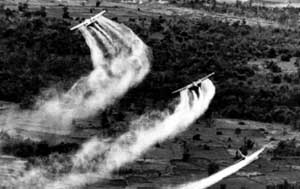
In this May 1966 file photo, U.S. Air Force planes spray the defoliant chemical Agent Orange over dense vegetation in South Vietnam.
Operation Ranch Hand marked the beginning of the aerial spraying of herbicides in Vietnam.
Agent Orange leaves behind a toxic footprint: Unfinished Business
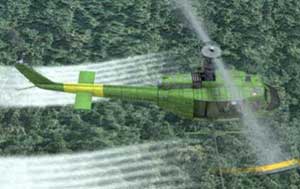
In addition to aerial spraying from planes and helicopters, soldiers on the ground sprayed Agent Orange on jungle foliage. More than 10 million gallons of Agent Orange were sprayed before its use was discontinued in 1971.
Agent Orange contained the toxic chemical dioxin. The contaminant was left behind in soil and water wherever Agent Orange was used and stored. Exposure to dioxin in large quantities poses health risks.

